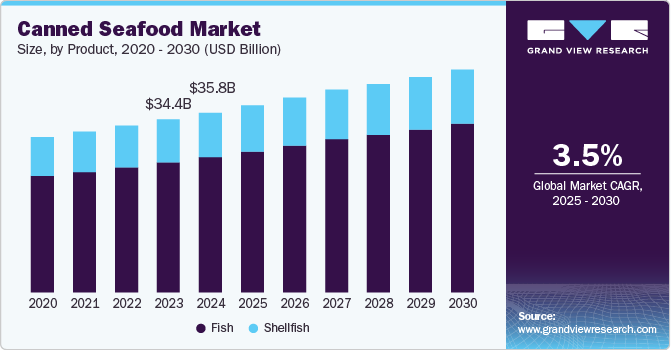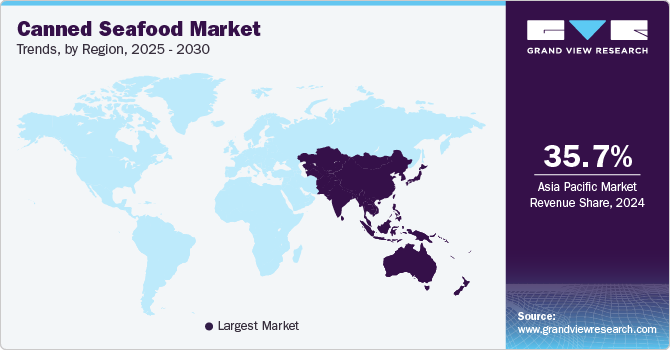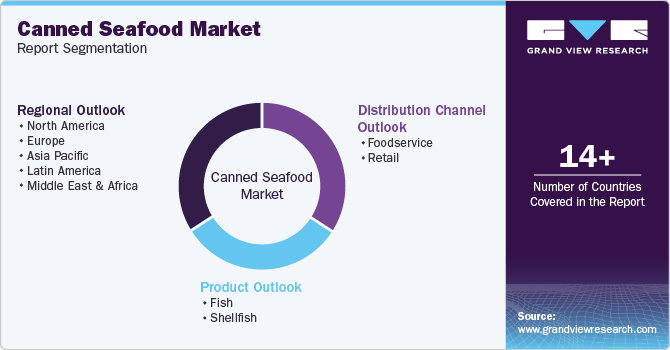
Canned Seafood Market Size, Share & Trends Analysis Report By Product (Fish, Shellfish), By Distribution Channel (Food Service, Retail), By Region (North America, Asia Pacific, Europe), And Segment Forecasts, 2025 - 2030
- Report ID: GVR-1-68038-644-8
- Number of Report Pages: 124
- Format: PDF, Horizon Databook
- Historical Range: 2018 - 2024
- Forecast Period: 2025 - 2030
- Industry: Consumer Goods
Canned Seafood Market Size & Trends
The global canned seafood market size was estimated at USD 35.77 billion in 2024 and is expected to grow at a CAGR of 3.5% from 2025 to 2030. The rising demand for convenience foods is significantly driving the growth of the canned seafood industry, reflecting broader trends in consumer behavior and market dynamics. As lifestyles become increasingly fast-paced, consumers are gravitating toward ready-to-eat and easy-to-prepare meals. This shift is particularly pronounced among working populations and younger generations, who often prioritize convenience due to time constraints associated with busy schedules.

The health benefits associated with canned seafood are enhancing its appeal. Canned seafood is recognized for its high nutritional value, particularly its rich content of omega-3 fatty acids and protein, which are essential for a balanced diet. As consumers become more health-conscious, there is a marked increase in demand for foods that not only save time but also contribute positively to health outcomes. This trend is further supported by a growing awareness of the importance of functional foods-those that provide health benefits beyond basic nutrition. Consequently, many consumers are willing to invest in higher-quality canned seafood products that promise both convenience and health benefits.
The market for canned seafood is also benefiting from improvements in distribution channels, which have made these products more accessible. Retail outlets, including supermarkets and convenience stores, play a crucial role in this expansion. The rise of online shopping has further facilitated access, allowing consumers to purchase canned seafood products with ease and often at competitive prices. This accessibility is vital in urban areas where busy lifestyles dominate, enabling consumers to stock up on pantry staples without frequent trips to grocery stores.
Sustainability is another critical driver of innovation in the market. Companies are increasingly adopting eco-friendly packaging materials and practices to reduce their environmental footprint. For example, John West's EcoTwist packaging not only reduces the amount of steel used but also eliminates the need for plastic shrink wrap, thereby decreasing overall packaging waste. The emphasis on sustainable packaging resonates with environmentally conscious consumers, enhancing brand loyalty and trust. Innovations such as the use of recyclable materials and the implementation of traceability features-like QR codes that inform consumers about the product's origin-are becoming standard practices that align with consumer expectations for transparency and responsibility.
Product Insights
Fish accounted for a global market share of 75.3% in 2024. One of the most significant drivers of the canned fish market is the increasing consumer awareness of health and nutrition. Fish, especially species like tuna, salmon, sardines, and mackerel, are rich in omega-3 fatty acids, high-quality protein, and essential vitamins and minerals such as Vitamin D and B12. Omega-3 fatty acids are known for their cardiovascular benefits, and there is growing evidence linking them to improved brain health.
The canned shellfish market is projected to grow at a CAGR of 3.2% from 2025 to 2030. The canned shellfish market is driven by both traditional and modern culinary applications that highlight the versatility and convenience of these products. Vintage recipes like seafood salads and fish casseroles, which often featured canned shellfish as a key ingredient, demonstrate a long-standing appreciation for these products, while current trends show a renewed interest among contemporary consumers. Social media platforms showcase creative dishes using canned shellfish, from simple prawns on toast to elaborate seafood charcuterie spreads, reflecting the evolving tastes of consumers.
Distribution Channel Insights
Sales of canned seafood through retail channels accounted for a share of 63.9% of the global revenue in 2024. The increasing sales of canned seafood through retail channels can be attributed to growing consumer demand for convenient and nutritious meal options. As more people lead busy lives, they seek quick, easy-to-prepare foods that do not compromise on quality or health benefits. Canned seafood fits this need perfectly, offering a rich source of protein and omega-3 fatty acids. Recognizing this trend, retailers have expanded their product ranges to include a variety of canned seafood options, from classic tuna to premium items like mackerel and sardines, appealing to health-conscious consumers looking for diverse, shelf-stable products that can be easily stored and incorporated into everyday meals.

The sales of canned seafood through food service channels are anticipated to grow at a CAGR of 4.0% from 2025 to 2030. Upscale restaurants are tapping into the rising trend of canned seafood by incorporating "conservas" spreads into their menus, often paired with curated wine selections. With a focus on expert presentation, simple canned seafood can be elevated when served alongside gourmet accompaniments like fine cheeses, cornichons, dried fruits, and toasted bread or crackers. This trend is particularly appealing to seafood enthusiasts who are excited about the resurgence of high-quality canned fish, and it provides a creative avenue for restaurants to differentiate their offerings and cater to evolving consumer tastes.
Regional Insights
North America canned seafood market accounted for a share of 18.6% of the global revenue in 2024. Increasing awareness about the health benefits of seafood, particularly its high protein content and omega-3 fatty acids, is a significant driver. Consumers are increasingly seeking nutritious and convenient meal options, and canned seafood, such as tuna, salmon, and sardines, offers a quick and easy way to incorporate these essential nutrients into their diets. The growing popularity of diets like Mediterranean and pescatarian, which emphasize seafood consumption, also contributes to the rising demand.
U.S. Canned Seafood Market Trends
The canned seafood market in the U.S. is projected to grow at a CAGR of 5.1% from 2025 to 2030 driven by several key factors that are shaping consumer preferences and industry trends. One of the primary drivers is the increasing demand for convenient and healthy food options. As consumers become more health-conscious, they are gravitating toward nutrient-dense foods, and canned seafood, rich in protein, omega-3 fatty acids, and essential vitamins, fits well within this trend. The convenience of canned seafood, which requires little preparation and has a long shelf life, also appeals to the fast-paced lifestyles of many Americans.
Europe Canned Seafood Market Trends
The canned seafood market in Europe is projected to grow at a CAGR of 2.8% from 2025 to 2030. European consumers are becoming more health-conscious, seeking food options that are both nutritious and sustainable. Canned seafood is often viewed as a healthy choice, rich in omega-3 fatty acids, vitamins, and minerals. Moreover, the growing awareness of sustainable fishing practices has led brands to emphasize sustainable sourcing and eco-friendly packaging, such as those certified by the Marine Stewardship Council (MSC). Such a step is gaining favor among environmentally conscious consumers, further driving the market.
UK canned seafood marketis projected to grow at a CAGR of 2.5% from 2025 to 2030. The market is benefiting from product innovations that cater to health-conscious consumers. For instance, brands are introducing nutrient-rich options and diversifying their product lines to include various seafood types, such as canned tuna, salmon, and shellfish. This variety allows consumers to choose products that align with their dietary preferences and health goals, further accelerating market growth. In addition, U.K. consumers are increasingly seeking sustainable food options, and canned fish is often viewed as an environmentally friendly choice, especially when sourced from responsible fisheries.
The canned seafood market in Germany is projected to grow at a CAGR of 2.4% from 2025 to 2030. Affordability also plays a critical role in the market dynamics. Canned seafood tends to be more cost-effective compared to fresh seafood, making it an attractive option during times of economic uncertainty or rising food prices. This affordability factor is particularly relevant in Germany, where consumers are increasingly mindful of their budgets while still seeking quality food products.

Asia Pacific Canned Seafood Market Trends
The canned seafood market in Asia Pacific accounted for a share of 35.7% of the global revenue in 2024. The market is driven by a combination of evolving consumer preferences, increasing urbanization, and rising disposable incomes. As lifestyles become busier, there is a growing demand for convenient food options that do not compromise on quality. Canned seafood, which offers a long shelf life and ease of preparation, fits this need perfectly. Urbanization has led to a greater concentration of populations in cities where convenient and ready-to-eat products are highly sought after. In addition, rising disposable incomes have expanded consumer choices, allowing more people to access premium canned seafood products.
Latin America Canned Seafood Market Trends
The canned seafood market in Latin America is projected to grow at a CAGR of 2.6% from 2025 to 2030. Latin America boasts rich marine biodiversity, which supports a variety of fishing practices across different countries. The availability of local fish species contributes significantly to the canned seafood market as manufacturers can source ingredients closer to home, reducing transportation costs and ensuring freshness. Countries such as Peru and Chile are known for their abundant fisheries, which provide raw materials for canned products such as tuna, sardines, and anchovies.
Middle East & Africa Canned Seafood Market Trends
The canned seafood market in the Middle East & Africa is projected to grow at a CAGR of 2.7% from 2025 to 2030. The increasing urbanization and busy lifestyles in the Middle East and African regions have led to a growing preference for convenience foods, including canned seafood. Consumers are seeking ready-to-eat options that require minimal preparation time, which has driven the popularity of products like canned tuna, sardines, and shrimp.
Key Canned Seafood Company Insights
The canned seafood market includes many domestic as well as international players. Key players in the global canned seafood market include StarKist Co., Thai Union Group PCL, Trident Seafoods, LDH (La Doria) Ltd, Wild Planet Foods, and American Tuna, Inc. Established players, such as global food and beverage giants, have been actively investing in research and development to innovate and introduce new canned seafood options. These companies leverage their extensive distribution networks and brand recognition to maintain a significant market share.
Key Canned Seafood Companies:
The following are the leading companies in the canned seafood market. These companies collectively hold the largest market share and dictate industry trends.
- Thai Union Group PCL
- StarKist Co.
- Trident Seafoods
- Tri Marine
- Maruha Nichiro Corporation
- Icicle Seafoods Inc.
- LDH (La Doria) Ltd
- American Tuna
- Universal Canning Inc.
- Wild Plant Foods
View a comprehensive list of companies in the Canned Seafood Market
Recent Developments
-
In June 2024, Thai Union announced the introduction of John West’s ECOTWIST, an innovative packaging solution that emphasizes user-friendliness, sustainability, and reduced waste. It is available in the U.K., one of the Thai Union’s key markets, with plans to potentially expand ECOTWIST to other countries. British consumers can find ECOTWIST at all Asda stores, with additional major retailers expected to follow shortly. The company has also introduced a patent-pending can tower for its tuna products, which utilizes a SmartStrip to hold the cans together, thereby eliminating the need for external packaging.
-
In June 2024, StarKist partnered with Cornerstones and Feed the Children to host the 3rd annual Summer Food and Resource Rally in Northern Virginia. This event aimed to provide food assistance and resources to families in need during the summer months when children are not receiving school meals. Through this partnership, StarKist, Feed the Children, and Cornerstones demonstrated a commitment to social responsibility and community service.
-
In July 2023, Wild Planet Foods established a new agreement with Whole Foods Market to introduce five of its seafood products in stores. These products consist of premium canned seafood that emphasizes sustainability. This collaboration enhanced Wild Planet Foods’ existing range of canned fish items available at the grocery retailer, ensuring low mercury levels and high-quality offerings. The new products featured at Whole Foods included Wild Smoked Pink Salmon in Extra Virgin Olive Oil, Wild Smoked Mackerel Fillets in Extra Virgin Olive Oil, Skipjack Solid Light Wild Tuna in Pure Olive Oil, Wild Tuna Quinoa Salad Ready-To-Eat Meal, and Wild Pink Salmon (3-Pack).
Canned Seafood Market Report Scope
|
Report Attribute |
Details |
|
Market size value in 2025 |
USD 37.20 billion |
|
Revenue forecast in 2030 |
USD 44.27 billion |
|
Growth Rate |
CAGR of 3.5% from 2025 to 2030 |
|
Actuals |
2018 - 2024 |
|
Forecast period |
2025 - 2030 |
|
Report updated |
October 2024 |
|
Quantitative units |
Revenue in USD million/billion, and CAGR from 2025 to 2030 |
|
Report coverage |
Revenue forecast, company ranking, competitive landscape, growth factors, and trends |
|
Segments covered |
Product, distribution channel, region |
|
Regional scope |
North America; Europe; Asia Pacific; Latin America; Middle East & Africa |
|
Country scope |
U.S, Canada, Mexico, Germany, U.K., Spain, Italy, France, China, India, Japan, Australia & New Zealand, Thailand, Brazil, UAE |
|
Key companies profiled |
Thai Union Group PCL, StarKist Co., Trident Seafoods, Tri Marine, Maruha Nichiro Corporation, Icicle Seafoods Inc., LDH (La Doria) Ltd, American Tuna, Universal Canning Inc., Wild Plant Foods |
|
Customization scope |
Free report customization (equivalent up to 8 analysts working days) with purchase. Addition or alteration to country, regional & segment scope. |
|
Pricing and purchase options |
Avail customized purchase options to meet your exact research needs. Explore purchase options |
Global Canned Seafood Market Report Segmentation
This report forecasts revenue growth at the global, regional, and country levels and provides an analysis of the latest industry trends and opportunities in each of the sub-segments from 2018 to 2030. For this study, Grand View Research has segmented the global canned seafood market report on the basis of product, distribution channel, and region.

-
Product Outlook (Revenue, USD Million, 2018 - 2030)
-
Fish
-
Tuna
-
Salmon
-
Trout
-
Sardines
-
Other Fishes
-
-
Shellfish
-
Prawns
-
Shrimps
-
Mussels
-
Crabs
-
Clams
-
Abalone
-
-
-
Distribution Channel Outlook (Revenue, USD Million, 2018 - 2030)
-
Foodservice
-
Retail
-
Hypermarkets & Supermarket
-
Grocery Stores
-
Online
-
Others
-
-
-
Regional Outlook (Revenue, USD Million, 2018 - 2030)
-
North America
-
U.S.
-
Canada
-
Mexico
-
-
Europe
-
Germany
-
U.K.
-
Spain
-
Italy
-
France
-
-
Asia Pacific
-
China
-
India
-
Japan
-
Australia & New Zealand
-
Thailand
-
-
Latin America
-
Brazil
-
-
Middle East & Africa
-
UAE
-
-
Frequently Asked Questions About This Report
b. The global canned seafood market was estimated at USD 35.77 billion in 2024 and is expected to reach USD 37.20 billion in 2025.
b. The global canned seafood market is expected to grow at a compound annual growth rate of 3.5% from 2025 to 2030 to reach USD 44.27 billion by 2030.
b. The Asia Pacific dominated the canned seafood market with a share of 35.7% in 2024. This is attributed to increasing in canned seafood product adoption due to the availability of a large quantity of raw material coupled with a large number of canneries in the region for aquaculture.
b. Some key players operating in the canned seafood market include StarKist Co., Nippon Suisan Kaisha, Ltd, Maruha Nichiro Corporation, Icicle Seafoods Inc., LDH (La Doria) Ltd, Wild Planet Foods, Thai Union Frozen Products, American Tuna, Inc., Universal Canning, Inc., Tri Marine Group, Trident Seafoods Corporation, Connors Bros. Ltd. (Brunswick Seafoods)
b. Key factors that are driving the canned seafood market growth include the increasing popularity of ready-to-eat seafood products due to improvement in distribution infrastructure is anticipated to drive the industry growth.
We are committed towards customer satisfaction, and quality service.
"The quality of research they have done for us has been excellent."




